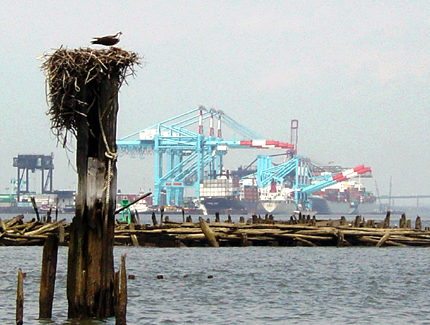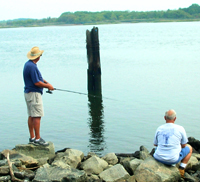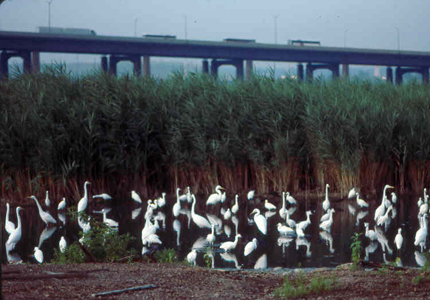
From his 30-foot wooden skiff, Andy Willner points out a sailboat headed north through the narrow tidal strait. A double-crested cormorant flies above, its sleek black form unmistakable on the powder blue sky. A grassy mountain rises behind the sailboat, stretching for miles. In a few hours, low tide will bring snowy egrets, glossy ibis and great blue herons by the score.
At this moment, it is easy to forget that the mountain is Fresh Kills Landfill, the largest landfill on earth, so massive it is among the few manmade structures that can be seen from space. Just as improbably, the water under the boat is the Arthur Kill, arguably America's busiest industrial waterway, lined on both sides with refineries and factories.
Since a massive oil spill in 1990, nature has staged a remarkable comeback here, thanks in large part to a newfound appreciation for how improvement of long-neglected waterways like the Arthur Kill can enhance the quality of life for millions of people.
The story of Arthur Kill is remarkable in and of itself. It also parallels the journeys of other industrial waterways in New York - from Newtown Creek to the Bronx River - that advocates hope will someday run clean, providing habitat for wildlife and recreation and respite for New Yorkers.

Launch the slideshow
Curtailing Pollution
Connecting Newark Bay with Raritan Bay along Staten Island's western shore, the Arthur Kill is vital to New York Harbor and the Hudson-Raritan Estuary. With the Manhattan skyline visible in the distance, thousands of tankers ship billions of gallons of oil through the strait each year, making the Arthur Kill more heavily traveled than the Panama Canal.
As recently as a few decades ago, the Arthur Kill was so polluted that crabs and clams would die within an hour of being submerged in its waters. That began to change with the passage of the Clean Water Act in 1972, which forced the construction of modern sewage treatment facilities throughout the metropolitan area.
"The Clean Water Act reduced sewage runoff, and the water improved dramatically," says Katharine Parsons, a senior scientist at Manomet Center for Conservation Sciences. "That allowed crabs and shrimp to recolonize the area, and the birds followed." Beginning in 1986, Parsons fund the numbers of egrets, herons and increasing by 15 percent each year.
That all changed on New Years Day 1990, when Exxon spilled 567,000 gallons of oil into Arthur Kill.
"We had just started monitoring the kill in 1989, and you talk about being baptized in oil," says Willner, who is retiring after 18 years as executive director for the environmental organization NY/NJ Baykeeper. "It was awful, but it led to the restoration and awareness of how important these wetlands were. These smaller parcels are like the last little gardens of Eden in this vast gray industrial area."
The oil spill was particularly damaging for birds such like snowy egrets and glossy ibis, which tends to be choosy eaters and could no longer rely on the crabs devastated by the massive oil spill.
For nature to bounce back, humans had to take a more active role. Later that year, New York City and the state Department of Environmental Conservation agreed to allocate $600 million to clean up Fresh Kills and other leaking city landfills. Federal agencies joined state and city agencies in New York and New Jersey in addressing the mounting debris, much of it from garbage barges going to Fresh Kills, that had ruined shorelines throughout the metropolitan area and forced hundreds of public beach closures in the late 1980s.
Through the Floatables Action Plan, over 350 million pounds of debris have since been collected from New York Harbor. By surveying the harbor and picking up the waste, the plan managed to control the driftwood, plastic bags and bottles, garbage barge waste, and other debris that lined the banks of Arthur Kill.
"Once people began managing a lot of the waste going to Fresh Kills, habitat started to develop," says Mark Gallagher, an environmental consultant who has worked on wetlands restoration projects. "When the shoreline was covered with floatables, it was awfully hard for herons to forage."
The infamous stench that often wafted over the region was finally corralled with the construction of a landfill gas extraction system that captures the methane and converts it into reusable natural gas.
The city shut Fresh Kills in 2001. That same year, Fresh Kills upgraded its leachate collection system, finally containing the hazardous runoff that had flown unabated into the Arthur Kill and New York Harbor for decades. Together the two events had a major effect. Recovery could begin - with a little help.
Rebuilding a Habitat

The area could begin to heal itself. "Nature has a built-in resilience to it," says Glenn Phillips, executive director of New York City Audubon. "For wetlands, their job is to mitigate the environment. If we leave them alone, let them do their work, they fix our mistakes."
Nature needed a little help, however. At restoration sites throughout the estuary, salt marshes destroyed by industry and oil spills are being replanted with native spartina alterniflora, a hardy salt-marsh cordgrass that may have evolved natural resistance to low levels of contamination.
Ecologists replanted six acres under the Goethals Bridge after the Exxon spill, and helped it become a thriving salt marsh again. Six acres is hardly a vast wilderness, but it is a start. Each of those single acres can hold a million fiddler crabs.
"It's the corniest line, but it really is true with tidal wetlands - if you build it, they will come," says Gallagher. "The very first day you let the tide come in, the fish and crabs come in with the tide. Soon after that you see birds... there to eat the fish."
The buffet lasts all year, as the Arthur Kill remains ice-free even during the fiercest winters. When ice seals off the Raritan River and other nearby rivers and lakes, thousands of buffleheads, mergansers and other ducks flock to the Arthur Kill at the mouth of its largest tributary, New Jersey's Rahway River.
Over 8,000 acres of the Arthur Kill watershed have been preserved, mostly along its tributaries. Nearly 4,000 wading birds now nest in the estuary. Many of them feed in the Arthur Kill and nest on the archipelago of small islands in Kill Van Kull and the East River. The abundance of the "harbor herons" would have seemed far-fetched a century ago, when many of these species were on the verge of extinction.
The Migratory Bird Treaty Act of 1914 allowed the herons and egrets to recover around the nation, but they seemed to be in no hurry to recolonize the filthy waters of the Big Apple. Now the recovering ecosystems of Fresh Kills Landfill attract birds migrating along the Atlantic Flyway, forming a substantial wildlife corridor with the William T. Davis Wildlife Refuge and the 2,500-acre Staten Island Greenbelt.
Other wildlife has returned as well.
Bill Schultz, the long-time Raritan Riverkeeper and a former Perth Amboy fireman, began wreck-diving in the Arthur Kill about 20 years ago. He has seen the harbor's biodiversity improve first-hand, encountering schools of fish swarming like a single organism, loggerhead sea turtles, and even a sand shark.
Most dramatic is New York Harbor's own Atlantic sturgeon - an armor-plated, toothless behemoth that evolved during the reign of the dinosaurs, and can grow as large as 12 feet long and weigh nearly 800 pounds.
People also are starting to return to this Industrial Venice. "There's no question public use is increasing in the Arthur Kill," says Willner, who kayaks the harbor with other environmentalists in a group they jokingly call "Nine Jerks," short for NY-NJ Endangered River Kayakers. "We see sailboats a lot, and people picnic in some spots and even swim or jet-ski."
At Staten Island's popular Tottenville Beach, visitors walk along outcrops of terminal moraine, where the Wisconsin Glacier reached its limit around 75,000 years ago. The Hudson River initially carved out the Arthur Kill - "kille" is the Dutch term for river channel - when its main channel was blocked by glaciers or moraine east of Staten Island. Those remnants of the last ice age remained visible on Tottenville's old roads, which were paved with millions of oyster shells in the early 1900s.
North of Tottenville, Fresh Kills now points the way to further use of the area. The Parks Department is transforming 2,200 acres of once-noxious land - nearly half of which is actual landfill - into a public park. Three times larger than Central Park, Fresh Kills will again be home to native habitat from maritime oak forest and pine barrens to salt marsh and native prairies, as well as athletic fields and nature trails.
The future park offers guided bus tours twice a month from April to November, and the tours fill up quickly, according to Parks Department spokesperson Trish Bertuccio.
"People are looking forward to creating new memories, and they're anticipating something great," she says. "We call it a park of the 21st century, catering to a new generation of park users that do things like kayaking, canoeing, mountain biking and watching birds, and maybe even horseback riding."
Construction of the park's first project, recreational fields at Owl Hollow, starts this spring. The complete Fresh Kills Park, however, is estimated to take at least 30 years.
The Challenges Ahead
Much still remains to be done for the Arthur Kill to fully recover.
"The progress has been extraordinary," says Baykeeper's Willner. "But like many places in the estuary, it's been one step forward, one step back."
The kill's undersea life - including bluefish, winter flounder and striped bass - offers a perfect example. The soaring population of fish has attracted recreational anglers and crabbers. But government advisories warn against frequent consumption of locally caught seafood, particularly for children and pregnant women.
"Some of the most contaminated areas still in New York Harbor are the sediments of Arthur Kill, Kill Van Kull, and Newark Harbor," says Parsons. "The sediment problems are not intractable, but they're very difficult. They're not just a problem for the birds, but for subsistence fishermen who may not understand the risks they're taking in eating contaminated fish."
Last year's New York City Audubon survey of the harbor herons also found no herons nesting on the Arthur Kill islands. "They nest in New York, but they almost entirely forage and feed in New Jersey," says Audubon's Phillips.
Experts attribute the Arthur Kill's nesting decline on raids on nests by raccoons and other mammals, human disturbance and a recent Asian longhorned beetle infestation, which required many suitable nesting trees to be destroyed.
For Parsons, the recent decline in breeding by wading birds in the Arthur Kill is telling.
"The legacy from the industrial era caught up to them," she says. "It caused the birds to not reproduce enough to be sustained. Even though they were successful, they were marginally successful."
"New York Harbor is definitely experiencing an improvement, a slow purging of the toxins the way you would expect," says Parsons. "It's a cause for hope, although not at the pace needed by these birds on the harbor today."
On to the Bronx and Brooklyn
As the activists of the Arthur Kill work to speed up a long-term recovery, similar goals are being pursued on polluted waterways across New York City.
In the heart of the Bronx, the Bronx River Alliance teamed with the New York City Department of Environmental Protection, the parks department, the Army Corps of Engineers and dozens of other groups, agencies and residents to restore the lower Bronx River, an eight-mile stretch infamous for its urban decay. The alliance combines monitoring and cleanups with recreation like greenway biking trails and kayaking programs.
The Canal, on the Brooklyn waterfront, was long known for its stagnant, putrid water. But in 1999, the environmental protection department reactivated the canal's pump system after 40 years of neglect.
"Now we have horseshoe crabs using the shallow water for their mating dance in the spring, then blue crabs coming in for mating, and by fall large schools of fish," says Owen Foote, a founder of the Gowanus Dredgers Canoe Club. "Shortly after sunset, the whole shoreline comes to life with the splashes where the big fish are eating the little fish."
The Gowanus Dredgers host public canoeing events and shoreline cleanups, and they've launched similar clubs along Newtown Creek between Long Island City and Greenpoint, the East River's Buttermilk Channel, and the Staten Island shoreline.
Still, the water is by no means pristine. "Our t-shirts on the back say, 'Don't flush when it rains,'" says Foote, "because the sewage plant can't handle the capacity and it goes straight into the water."
The DEP last year approved a $125 million water quality improvement plan to modernize the canal's pumping station and reduce the levels of sewage discharge into the Gowanus. While this will help, heavy rains will still send sewage into the canal.
New York City's sewage problem is hardly limited to the Gowanus. Each year, an estimated 27 billion gallons of raw sewage and polluted stormwater enter New York Harbor, a particular problem for sheltered waterways such as the Gowanus.
While modernizing the sewage system will take years and cost millions, source controls - planting more trees and vegetated areas - could prove equally effective at capturing the stormwater before it enters the sewage system. Cities such as Chicago and Washington D.C. successfully utilize similar greening measures to control runoff.
The challenges facing New York Harbor are many. But if the Arthur Kill can start to recover, with all the deadly destruction heaped into its water and along its shoreline, there is hope yet for just about any waterway.
The seeming contradictions of the Arthur Kill and other urban waterways - nature returning despite continued pollution, stunning wildlife vistas set to a backdrop of heavy industry - reflect New York's legacy as both a center of commerce and a city built atop an estuary.
After centuries of treating the waterways as open sewers, humans appear to be the best bet for creating a new legacy for New York Harbor. "We encourage direct contact with the water itself," says Foote, "because then you see the need to clean it up."
David Wheeler is a freelance writer and the director of operations for the Edison Wetlands Association, a non-profit environmental organization that works on environmental restoration in New Jersey.Â




